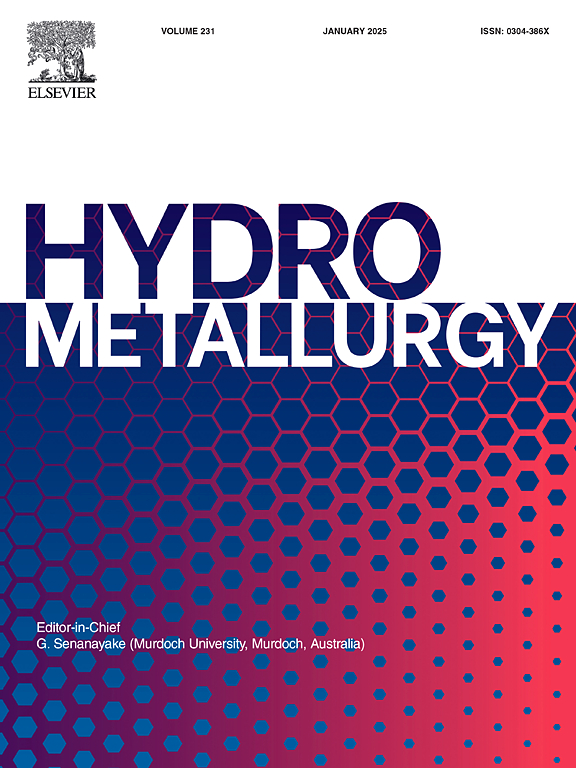Dissolution of scheelite under soft acidic conditions via the formation of polyoxotungstate: kinetics and mechanism supported by small-angle X-ray scattering (SAXS) to identify and quantify H3PW12O40
IF 4.8
2区 材料科学
Q1 METALLURGY & METALLURGICAL ENGINEERING
引用次数: 0
Abstract
The decomposition of scheelite in a synergistic H2SO4-H3PO4 mixture is an effective method for extracting tungsten from mining concentrates. The driving force behind the dissolution of scheelite in the H2SO4-H3PO4 mixture is the formation of a soluble Keggin-type polyoxotungstate, H3PW12O40, which prevents the formation of very low solubility tungstic acid. In this work, a multiparametric study of scheelite dissolution kinetics was carried out in a synergistic acid mixture. In particular, the independent contributions of temperature, acid concentration, and W:P molar ratio on scheelite dissolution kinetics and H3PW12O40 formation yield were evaluated. To this end, a method based on the use of small-angle X-ray scattering (SAXS) was developed to identify and quantify H3PW12O40 under different operating conditions. The results provide a better understanding of the stability range of H3PW12O40 in terms of H2SO4 concentration and stoichiometric W:P ratio. These findings led to the selection of optimized, soft-leaching conditions that ensure rapid dissolution of scheelite while avoiding surface passivation by the precipitation of secondary phases. A comparison with speciation calculations using thermodynamic data reported in the literature reveals an absence of a self-consistent thermodynamic dataset. Thus, measuring the concentration of H3PW12O40 in the leachate was necessary to optimize the dissolution conditions. From this perpective, SAXS appears to be a suitable quantitative method.
软酸性条件下白钨矿溶解形成多钨氧酸盐:小角x射线散射(SAXS)鉴定和量化H3PW12O40的动力学和机理
在H2SO4-H3PO4协同混合物中分解白钨矿是一种有效的从选矿精矿中提取钨的方法。白钨矿在H2SO4-H3PO4混合物中溶解的驱动力是可溶性keggin型多钨氧酸盐H3PW12O40的形成,阻止了极低溶解度钨酸的形成。本文对白钨矿在协同酸混合物中的溶解动力学进行了多参数研究。研究了温度、酸浓度和W:P摩尔比对白钨矿溶解动力学和H3PW12O40产率的独立影响。为此,开发了一种基于小角度x射线散射(SAXS)的方法来识别和量化不同操作条件下的H3PW12O40。从H2SO4浓度和化学计量W:P比两个方面对H3PW12O40的稳定性范围有了更好的理解。这些发现有助于选择优化的软浸条件,以确保白钨矿的快速溶解,同时避免二次相的沉淀导致表面钝化。与文献中报道的使用热力学数据的物种形成计算的比较揭示了缺乏自一致的热力学数据集。因此,有必要测量渗滤液中H3PW12O40的浓度,以优化其溶解条件。从这个角度来看,SAXS似乎是一种合适的定量方法。
本文章由计算机程序翻译,如有差异,请以英文原文为准。
求助全文
约1分钟内获得全文
求助全文
来源期刊

Hydrometallurgy
工程技术-冶金工程
CiteScore
9.50
自引率
6.40%
发文量
144
审稿时长
3.4 months
期刊介绍:
Hydrometallurgy aims to compile studies on novel processes, process design, chemistry, modelling, control, economics and interfaces between unit operations, and to provide a forum for discussions on case histories and operational difficulties.
Topics covered include: leaching of metal values by chemical reagents or bacterial action at ambient or elevated pressures and temperatures; separation of solids from leach liquors; removal of impurities and recovery of metal values by precipitation, ion exchange, solvent extraction, gaseous reduction, cementation, electro-winning and electro-refining; pre-treatment of ores by roasting or chemical treatments such as halogenation or reduction; recycling of reagents and treatment of effluents.
 求助内容:
求助内容: 应助结果提醒方式:
应助结果提醒方式:


